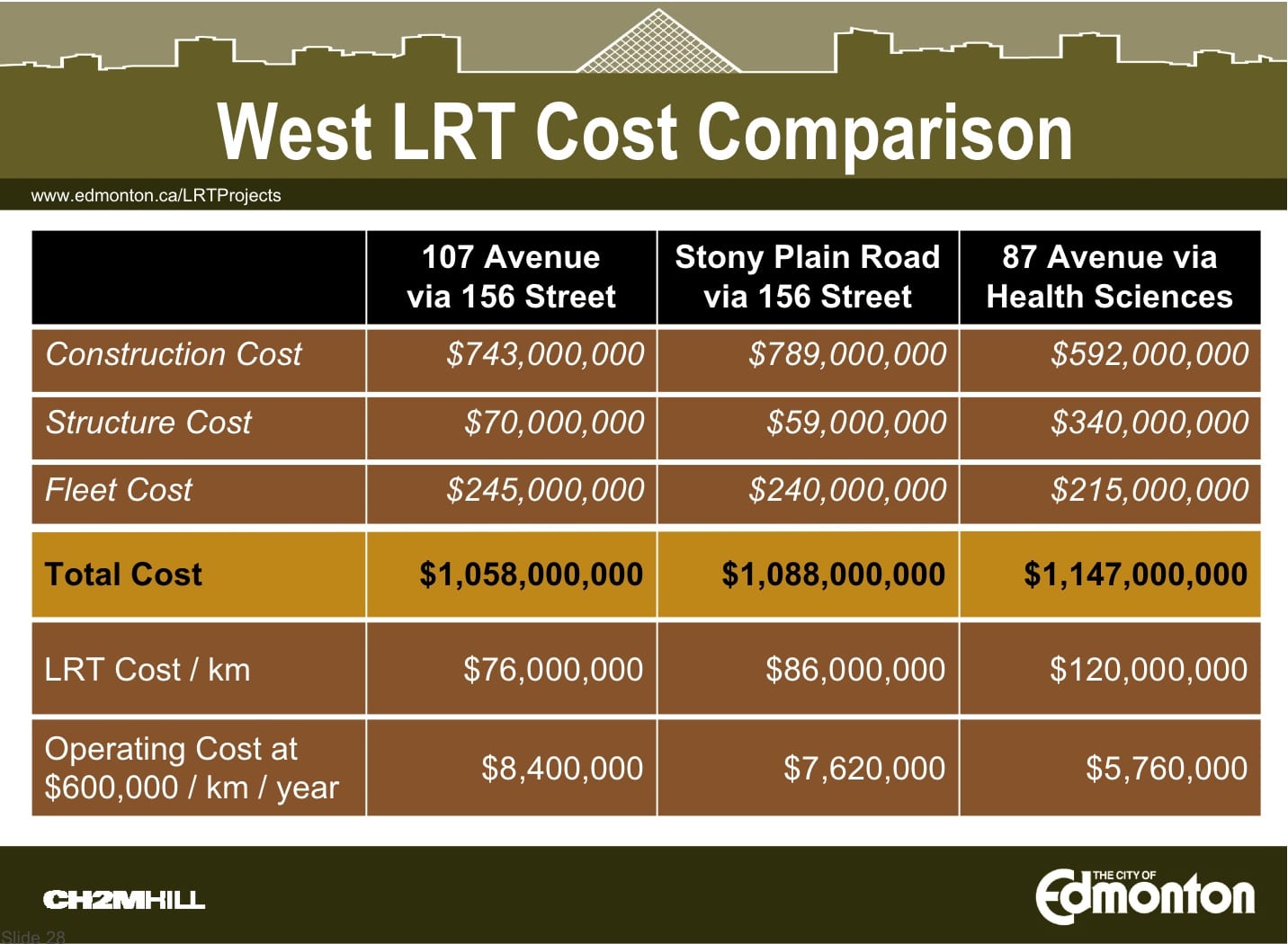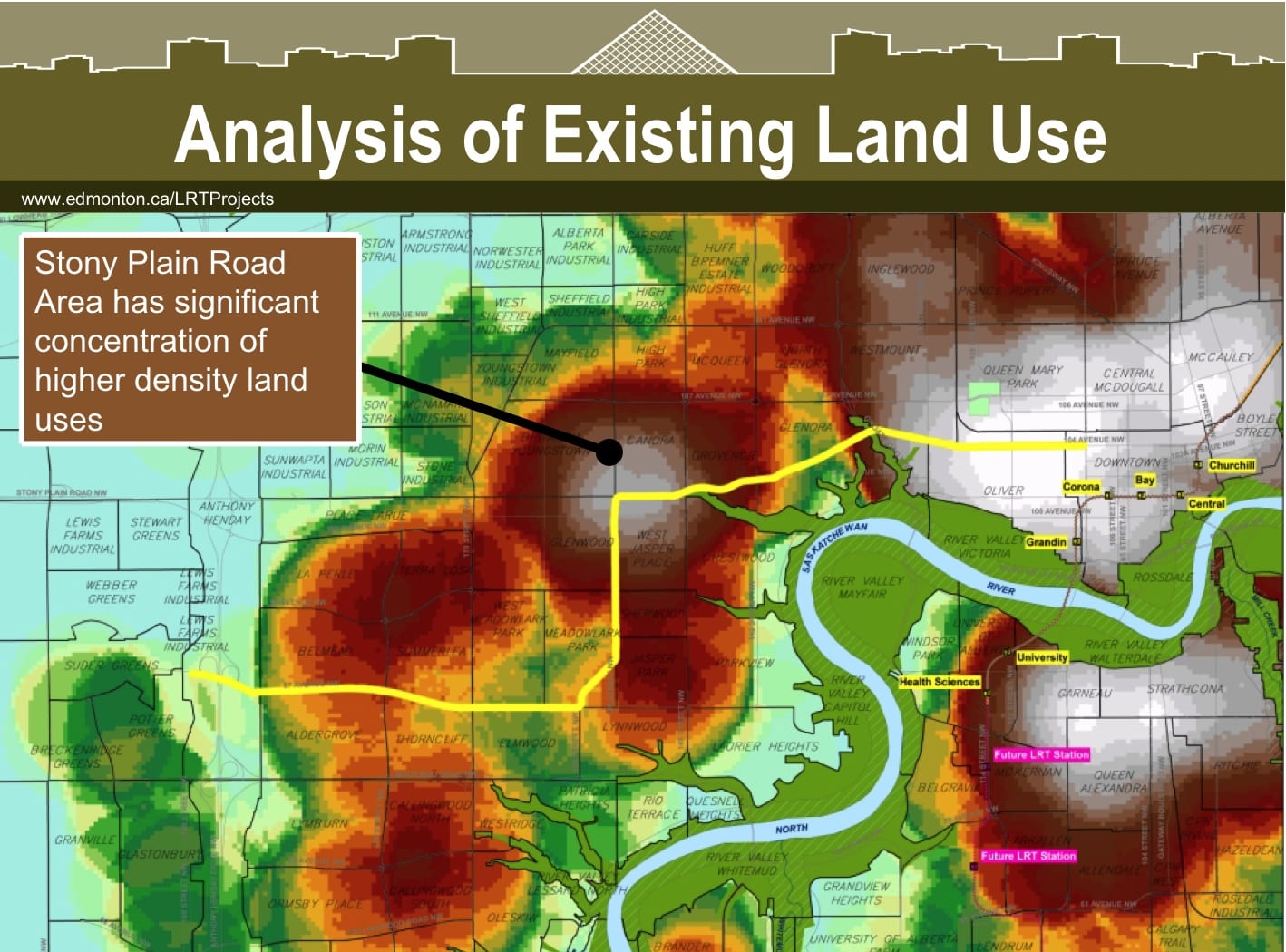West LRT Follow Up
I had indicated the other day on this blog that I was hesitant about the proposed Stony Plain Road LRT alignment, at least the part between 156 St and 121 Street. I had a number of questions, most of which were addressed in one of the most cogent presentations I’ve ever seen from city staff.
The video recording is not posted yet on the city website, but the PDF of their presentation is downloadable at this link.
Some of the potential upsides of 107 Ave that I had been interested in exploring were discussed, and the main one was the cost difference. On closer examination, the spread between SPR and 107 Ave was not $200-300 million, it’s more like $30 million cheaper to build 107 Ave, but it would be more expensive to operate because it’s further and would require more Light Rail Vehicles.
Admittedly, there is an interpretation of the slide above that would lead one right back to 87 Ave route, but the slide below is the best visual representation of what’s wrong with 87 Ave from an urban point of view.
I do think there’s still a lot at risk with this choice, but I think that Council is aware of those risks and will work to mitigate them. I was reminded of an earlier amendment I proposed to our Transportation Master Plan that established a policy of ‘precursor’ premium bus service on planned LRT routes, which if followed through on will be positive for SPR.
So after yesterday’s debate, I felt able to support the bylaw. Much of the concerns citizens and councillors still have will be dealt with at the next phases of more detailed design and engineering (like snow removal, managing the construction disruption, etc.). Many people would like to see that level of detail before a route is settled on by council, but it’s very expensive and, therefore, impractical to do this for all the alternatives. So now we can study SPR and if a fatal flaw emerges in that analysis Council and the public will know about it.
Incidentally, the bylaw also included the plan for Downtown to Millwoods and a small change to the NAIT line to shift the tracks onto the airport lands instead of running up 106 Street, which is a big step toward airport redevelopment.
My main message yesterday is speaking to the bylaw: now we have a plan to show Ottawa and the province, and we can press the question of whether they will invest in Edmonton or not. Our citizens want LRT, but it won’t get built without at least one more order of government in the mix.
So who’s in?


Interesting. From all the talk of bulding a compact urban form, I would have thought the Stony Plain Road area would be less dense than 87th avenue communities.
We keep hearing that if a fatal flaw is found, the route may change again. What are the metrics of a fatal flaw? Is it dollars? Technical issues? Public Outcry?
Council and the public can only be watchdogs if we know the rules going in.
Sounds good, I’m certainly happy to hear that density is a significant factor in y’all’s decision making. Will circulate ’round the office.
David, A report on just those questions is coming to TPW committee in the new year, just to clarify the process, general thresholds and key decision points. Cllr. Sloan proposed a motion (passed) asking for notification if the estimated costs exceeded the contingency amounts in the current estimates.
Don, I respectfully disagree that Transportation answered all of the questions raised during the public hearing.
For instance, why were Edmontonians never told that – as a consequence of not connecting West LRT to the existing system south of Health Sciences Station using 87 Avenue – a tail track with its own platform will have to be constructed south of HSS so that trains on the NAIT line can reverse direction? And given the ROW constraints, where will this tail track be located?
Furthermore, how could the Administration estimate the fleet cost for SPR to be only about 11% higher than 87 Avenue, when the track length is 44% longer?
My concern is that there is little evidence to suggest that LRT expansion can inspire density (just look at the existing NE leg). TOD is more theory than fact at this point and I’m starting to believe this is lost on council and the public. I’m also a little worried about the speed of travel on a low floor system; an elevated line from the Lewis, past the Mall down 87th to the U coupled with a low-floor streetcar system down SPR/104 makes more sense than trying to find one solution for two problems.
John, as I indicated to you in previous discussions about this matter, the NAIT line will almost certainly open long before the West LRT, meaning this turnaround issue will manifest and need to be dealt with regardless of the Western route selection. If SPR, it’s a permanent issue. It would have been temporary in the case of an 87 Ave route.
As for the vehicle costs I would have to guess that this depends on how you pro-rate the NAIT line vehicle costs in the equation, and the relative cost of low-floor and high-floor vehicles.
Don, and that’s why I’ve suggested that a station near the Cross Cancer Institute be constructed as part of the NAIT line as an alternative to constructing a tail track with a platform that is only used by the driver to change ends. And given the right of way constraints south of Health Sciences Station, I’m still waiting for an answer on where this tail track would be constructed?
The number of vehicles required for a route is determined by the frequency of service during peak periods and track length. Since the track length of the SPR route is 44% longer than 87 Avenue (60% longer if you include the downtown connector), 44% more vehicles will be required assuming similar frequency of service and ridership.
On relative costs of the low-floor and high-floor vehicles, it depends on the specifications for each. Estimating the vehicle costs for an 87 Avenue route should be pretty straightforward given that they would likely be the same Siemens trains as Edmonton currently uses. I’m not sure how Transportation estimated the vehicle costs for the SPR route since it’s my understanding that no decision has been made on what type of low-floor vehicle will be used.
So I ask again, how can the vehicle costs for the SPR route only be 11% higher than 87 Avenue, when the track length is 44% longer (60% longer if the downtown connector is included)?
I also wanted to briefly comment on the ‘Analysis of Existing Land Use’ map above. This map is nothing short of a complete fabrication.
Given that the predominant existing land uses in the Stony Plain Road area are single story commercial buildings, small walk-up apartments, duplexes and even a sprinkling of single family houses, what possible justification is there for showing this area as white hot on the map? Just to make sure Council didn’t miss the point, Transportation inserted a text box reinforcing the message.
Meanwhile, the two highest density residential developments along 87 Avenue (Meadowlark Village at 165 Street, and Whitehall Square at 155 Street) are shown as cool orange or even green. Whitehall Square (with its 3 high rise towers and 9 low-rise apartment buildings) is bypassed by the SPR route.
@Adam Re: TOD theory vs practice
Transportation Cooperative Research Program Report of 2008 studied 17 TOD areas in major metro areas in the U.S. They found that there were 44% fewer auto trips, and the parking demand was halved in a typical weekday period.
Don, just for your viewing pleasure, I would like to suggest the following link. There’s nothing quite like reality in motion.
http://www.youtube.com/watch?v=CV2rdGX4JYc
@Dave J – are you twelve years old? Interesting way to add to the debate.
I lived in Edmonton in the 1990s in my 20s and constantly got called a failure and a loser because I used LRT. I fail to understand why LRT construction never started back then as it would have created a lot of jobs and long term benefits. Even Jan Reimer the mayor at the time was laughed at.
I am happy to see FINALLY that Edmonton is taking LRT construction seriously. The older generation doesn’t buy it but the younger generation will.
Congratulations. I moved to Calgary specifically because we have a better LRT system.